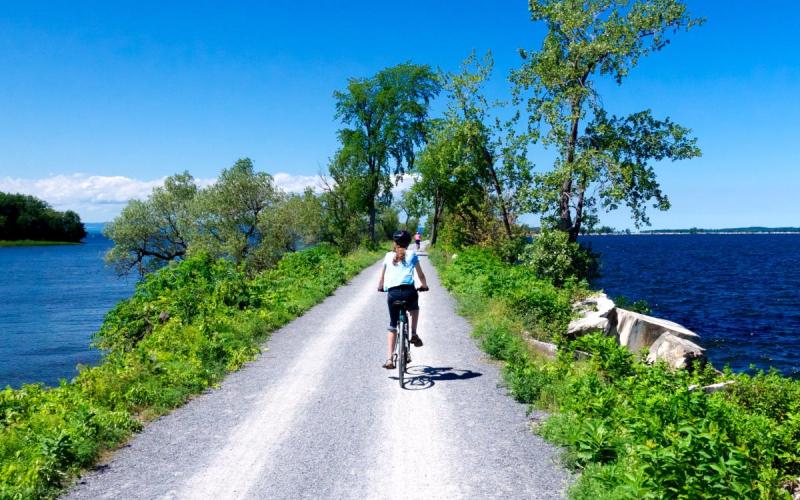
Explore The Lake Champlain Watershed
The Lake Champlain watershed—all the land that drains into the Lake Champlain basin—encompasses 8,234 square miles and extends into New York, Vermont, and Quebec. The watershed area is 19 parts land for every 1 part water, meaning people affect the lake ecosystems—even miles away from the lake. Lake Champlain is culturally, ecologically, and economically central to communities in and near its watershed. Indigenous groups—including the Abenaki, Mohawk, and Mohican Peoples—have stewarded these lands and waters for thousands of years and continue to steward them.
There is plenty to do when visiting the Lake Champlain Basin, below are some great summer activities. While you’re enjoying all Lake Champlain has to offer, learn how to do your part to make it a safe, clean environment. If you’ll be near Colchester on Fridays in June, July, or August, join us between 10am and 2pm while you wait for the bike ferry on the Colchester Causeway to learn about our Little Lake Lessons.
Swim
Lake Champlain has over 50 public beaches. You can find beaches near you on this handy map. While the lakeside beaches are great, check out some swimming spots that aren’t right on the shores, too. Here is a list of local swimming holes and river spots in Vermont that can be good for taking a dip, catching a fish, or cliff jumping.
Beach closures are not common, as Lake Champlain is known for its pristine waters. However, due to recent human influences and climate change, some beaches have short-term closures throughout the summer season. Double check for signs of beach closures before you or your animals swim. Before you go learn about cyanobacteria blooms and, if you're in Vermont, you can check here for local beach closures.
Fish
Lake Champlain is home to 93 fish species, and anglers fish for 20 species for food or sport. You can fish in the main lake or in streams and rivers that feed into the lake. Go to the Vermont or New York State Fish and Wildlife websites to learn about what, where, and when you can fish. If you are looking to fish for food, read about the best practices for minimizing mercury consumption.
While there is much native aquatic life, Lake Champlain also struggles with Aquatic Invasive Species (AIS). 51 Aquatic Invasive Species have been found in Lake Champlain. Lake Champlain is monitoring and controlling Aquatic Invasive Species well compared to neighboring ecosystems such as the Great Lakes, but multiple invasive species are looming, including round goby fish and quagga mussels. Read more about Lake Champlain Aquatic Invasive Species.

Boat
Whether by motorboat, sailboat, or kayak, Lake Champlain is spectacular from the water! If you’re just visiting, you can rent a kayak or charter a sailboat in Vermont and New York. If you’re bringing a boat that you have used in another water body, refer to the guidelines for cleaning off your boat on our website before and after entering the watershed. Also, download the pumpout nav app to learn where facilities that can pump out your boat are on the lake.
Bike
There are beautiful bike routes on the shores of Lake Champlain and throughout the watershed. These downloadable maps and guides can help you plan your bike trip. Local Motion in Vermont and The Adirondack Coast in New York provide rental bikes for visitors, so you can take a ride even if you’re only here for a few days.
One classic trip is from Burlington’s bike path to the causeway in Colchester, Vermont to bike on the old train tracks across the open lake. Please join us while you wait for the bike ferry on Fridays and Saturdays in June, July, and August this summer to learn about our Little Lake Lessons. The bike ferry will take you across the channel to the Champlain Islands and back.
Relax
With 587 miles of shoreline, there are numerous places to set out a blanket or chair and enjoy Lake Champlain. On the Vermont side, you can enjoy the sunsets over the Adirondacks and, on the New York side, you get the sunrises over the Green Mountains. Check out local state parks in Vermont and New York.
Learn More
Help to ensure that all people can live, work, and enjoy the Lake Champlain watershed. Learn about threats and challenges Lake Champlain faces—such as climate change, flooding, cyanobacteria, and stormwater runoff—or sign up for our monthly newsletter to get information sent straight to your inbox.